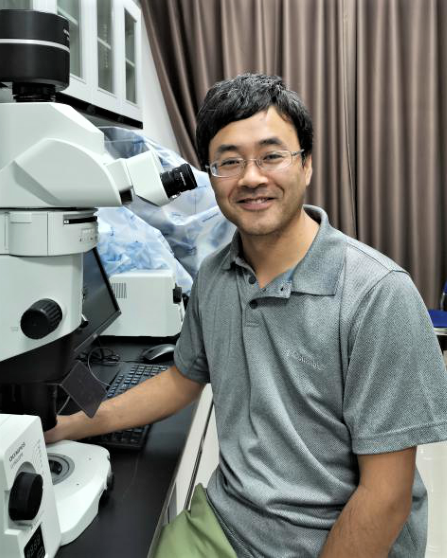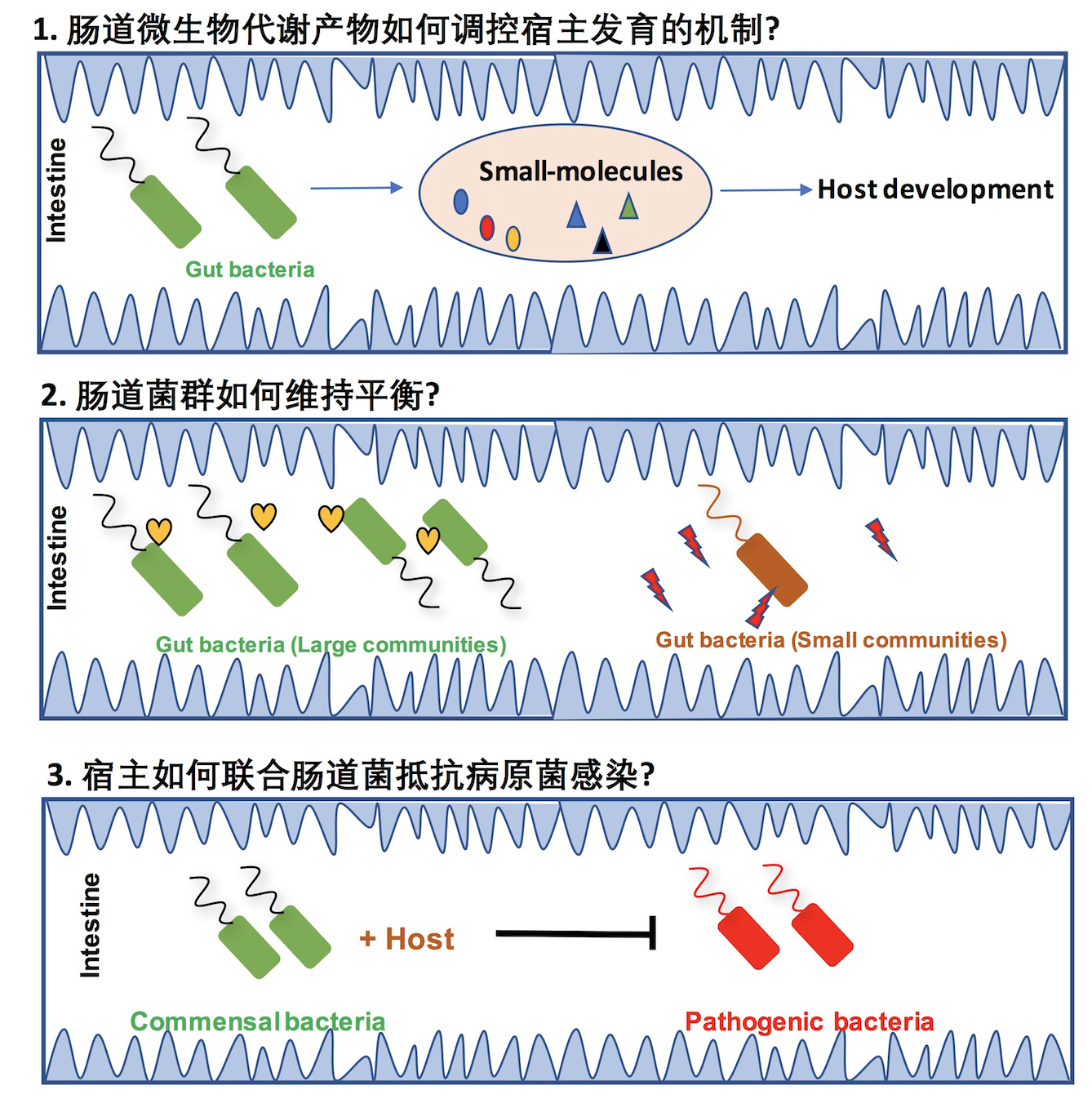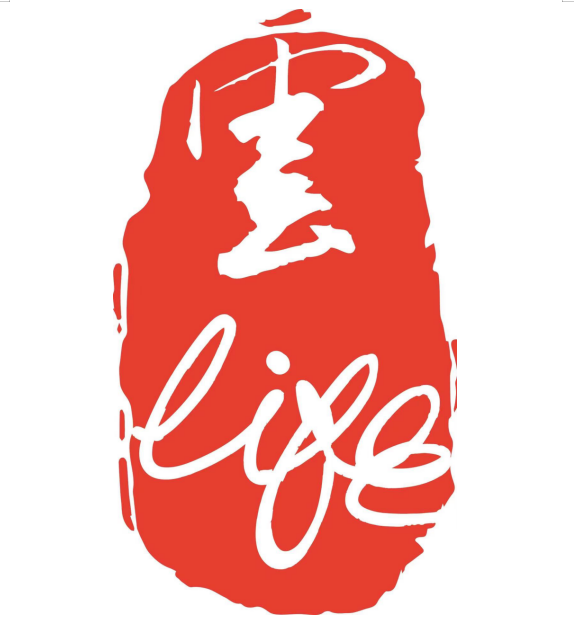
祁斌
祁斌,云南大学生命科学学院/中心研究员。实验室以秀丽隐杆线虫(C. elegns)为模式生物,研究微生物与宿主消化系统、免疫系统互作。其研究成果发表在Cell Host & Microbe、eLife、Cell Reports、Nature Communications、Cell等主流期刊。主持国家海外高层次人才青年项目、国家重点研发计划“发育编程及其代谢调节”重点专项(青年项目)、国家自然基金面上项目、云南省“杰出青年”等项目。Email:qb@ynu.edu.cn
阐明宿主肠道内微生物群衍生分子的功能对于理解人类与其微生物群之间的共生关系非常重要。为什么动物肠道需要微生物呢?本课题组以线虫为模式生物,建立了宿主和微生物的筛选体系,发现:
1)肠道微生物次级代谢产物enterobactin(肠杆菌素)促进宿主对铁的吸收和利用(Cell,2018)
2)肠道微生物次级代谢产物维生素B2调控宿主肠道蛋白酶活性,从而促进动物对食物的利用(eLife, 2017)。
今后,课题组将以线虫、无菌小鼠为模式生物,重点研究以下问题:

欢迎本科生,博士后加入我们的团队,共同探索未知的领域。且欢迎广大科研爱好者来实验室交流,学习,访问,合作。
Google Scholar: https://scholar.google.com/citations?hl=en&user=mmGdRJwAAAAJ
1. Sucheng Zhu#, Xinyi Zhou#, Bin Qi. (2024). Host-pathogen Coadaptation by running with PAR protein. bioRxiv, doi: https://doi.org/10.1101/2024.01.31.578330
2. Yating Liu#, Guojing Tian#, Ziyi Wang, Junkang Zheng, Huimin Liu, Sucheng Zhu,
Zhao Shan*, Bin Qi* (2024). Neuronal Detection Triggers Systemic Digestive Shutdown in Response to Adverse Food Sources. eLife (Under Review).
预印版本Neuronal Detection Triggers Systemic Digestive Shutdown in Response to Adverse Food Sources. bioRxiv 2024.11.01.621469;
doi: https://doi.org/10.1101/2024.11.01.621469
3. Yating Liu#, Qian Li#, Guojing Tian, Xinyi Zhou, Panpan Chen, Bo Chen, Zhao Shan*, Bin Qi* (2024). Neuronal PRDX-2-Mediated ROS Signaling Regulates Food Digestion via Intestinal UPRmt Activation. Nature Communications. https://doi.org/10.1038/s41467-024-55013-3
4. Huimin Liu#, Panpan Chen#, Xubo Yang#, FanRui Hao, Guojing Tian, Zhao Shan*, Bin Qi*. (2024). Probiotics-sensing mechanism in neurons that initiates gut mitochondrial surveillance for pathogen defense. Cell Reports.
https://doi.org/10.1016/j.celrep.2024.115021
预印版本Bacterial sensing via Neuronal Receptor Initiates Gut Mitochondrial Surveillance for Host Adaptation. bioRxiv, https://doi.org/10.1101/2024.10.08.615749
5. Liu, P., Liu,X., and Qi, B. (2024). UPRER–immunity axis acts as physiological food evaluation system that promotes aversion behavior in sensing low-quality food. eLife, https://doi.org/10.7554/eLife.94181.1
6. Chen Y#, Yang R#, Qi B*, Shan Z*. (2024). Peptidoglycan-Chi3l1 interaction shapes gut microbiota in intestinal mucus layer. eLife,
https://doi.org/10.7554/eLife.92994.1
7. Xuepiao Pu, Bin Qi. (2024). Lysosomal dysfunction by inactivation of V-ATPase drives innate immune response in C. elegans. Cell Reports,
https://doi.org/10.1016/j.celrep.2024.114138
8. Fanrui Hao#, Huimin Liu,# Bin Qi. (2024). Bacterial peptidoglycan acts as a digestive signal mediating host adaptation to diverse food resources in C. elegans. Nature Communications,
https://www.nature.com/articles/s41467-024-47530-y
9. He, Y#., Hao, F#., Fu, H., Tian, G., Zhang, Y., Fu, K., and Qi, B. (2023). N-glycosylated intestinal protein BCF-1 shapes microbial colonization by binding bacteria via its fimbrial protein. Cell Reports 42, 111993. https://doi.org/10.1016/j.celrep.2023.111993
10. Huimin Liu and Bin Qi. (2023) Protocol for investigating the effect of food digestion in C. elegans on development by feeding the inedible bacteria Staphylococcus saprophyticus.
Star Protocols. https://doi.org/10.1016/j.xpro.2022.101990
11. Geng, S#., Li, Q#., Zhou, X#., Zheng, J#., Liu, H#., Zeng, J., Yang, R., Fu, H., Hao, F., Feng, Q., and Qi, B. (2022). Gut commensal E. coli outer membrane proteins activate the host food digestive system through neural-immune communication. Cell Host & Microbe.
https://doi.org/10.1016/j.chom.2022.08.004
Previewed by Kaveh Ashrafi, Better living through communal eating. Cell Host & Microbe
. 2022 Oct 12;30(10):1343-1344. https://doi.org/10.1016/j.chom.2022.09.005
Reviewed by Grant Otto, Gut commensals activate digestion. Nature Reviews Microbiology 20, 637 (2022). https://doi.org/10.1038/s41579-022-00799-6
2019年之前(博后、研究生阶段论文):
12. Sewell, A.K., Han, M., and Qi, B. (2018). An unexpected benefit from E. coli: how enterobactin benefits host health. Microbial cell 5, 469-471.(Cover)
13. Qi, B., and Han, M. (2018). Microbial Siderophore Enterobactin Promotes Mitochondrial Iron Uptake and Development of the Host via Interaction with ATP Synthase. Cell 175, 571-582.e511. https://doi.org/10.1016/j.cell.2018.07.032
(Accompanied by a Preview by Dennis H. Kim, Bacterial Siderophores Promote Animal Host Iron Acquisition and Growth. Cell, https://doi.org/10.1016/j.cell.2018.09.020 )
(Reviewed by Gregory J. Anderson, Iron Wars — The Host Strikes Back. The New England Journal of Medicine. 2018, DOI: 10.1056/NEJMcibr1811314 )
14. Qi, B., Kniazeva, M., and Han, M. (2017). A vitamin-B2-sensing mechanism that regulates gut protease activity to impact animal's food behavior and growth. eLife 6.
https://elifesciences.org/articles/26243
15. Zhang, F#., Qi, B#., Wang, L#., Zhao, B., Rode, S., Riggan, N.D., Ecker, J.R., and Qiao, H. (2016). EIN2-dependent regulation of acetylation of histone H3K14 and non-canonical histone H3K23 in ethylene signalling. Nat Commun 7, 13018. (#co-first author)
16. Qi, B., and Zheng, H. (2013). Modulation of root-skewing responses by KNAT1 in Arabidopsis thaliana. The Plant Journal 76, 380-392.


